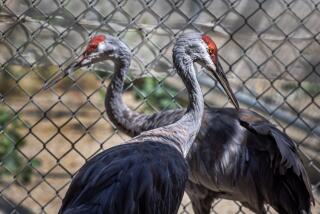Ready to Take Wing : Six Captive-Bred Condors Are Flown to a Cave in the Wilderness
Six young California condors were flown by helicopter Monday from the Los Angeles Zoo to a cave-like enclosure high in the rugged Ventura County backcountry in preparation for their release into the wild in a few months.
The six, which were hatched and raised at the zoo, will join Xewe, (pronounced GAY-wee), a 17-month-old condor that was one of the first two of the endangered species to soar in the wild since the last of the giant vultures was captured in 1987.
The other condor released in January, Chocuyens (Cho-KOO-yenz), died Oct. 8. Biologists are waiting for toxicology and other test results to determine the cause, wildlife scientists at the Los Angeles Zoo said.
The six condors, four females and two males ranging in age from 5 to 7 months, will be held in the same simulated cave that U.S. Fish and Wildlife biologists built for Xewe and Chocuyens last year.
The enclosure, with a net-covered porch and an electrified fence to keep out bears and other intruders, sits atop the 150-tall Arundell Cliff in Sespe Condor Sanctuary, about 20 miles north of Fillmore. There, the birds will be monitored by federal biologists on 24-hour watches until they are released in December or January.
After heavy morning fog delayed the airlift by more than two hours, Ventura County sheriff’s helicopters made three trips, carrying the six chicks in groups of two. On board each flight was at least one veterinarian and one biologist.
Michael Wallace, curator of birds for the zoo and a member of the Condor Recovery Team assembled by the Fish and Wildlife Service, rode along on the last of the 40-minute, 50-mile flights.
“It was exhilarating,” said Wallace. Because the birds were familiar with each other, they were “exploring and eating and a lot more relaxed than last time when they were hissing and snapping at each other.”
The goal of the recovery program is to establish three separate populations of 150 birds each, one in the Sespe Condor Sanctuary, one at the zoo and a third at the Grand Canyon. Once that population level is achieved, the U.S. Fish and Wildlife Service would move to take the birds off the endangered species list.
Wallace said the young birds have a lot to learn about living in the wild.
“They’re like little kids running around putting everything into their mouths,” he said.
The carrion-eating California condor, which once numbered in the thousands, was on the brink of extinction when scientists decided in 1986 to capture the last of the wild birds.
AC-9, Xewe’s father, was captured on Easter in 1987, marking the first time since the Pleistocene era 2 million years ago that no condors flew in North American skies.
Many of the birds were killed by hunters and lead poisoning over the years.
Condor Names
The six California condors taken from the Los Angeles Zoo to Ventura County have all been assigned Chumash Indian names. They are:
* Haku, pronounced Ha-coo, meaning hello. A female.
* Pitashi, pronounced Pi-tah-she, meaning understanding. A female.
* Hutash, pronounced Who-tosh, meaning Earth. A female.
* Koyo, pronounced Ko-yoa, meaning beginning. A female.
* Sqap, pronounced Ssh-kap, meaning feather bundle. A male.
* Niko, pronounced Knee-co, meaning water. A male.
More to Read
Sign up for Essential California
The most important California stories and recommendations in your inbox every morning.
You may occasionally receive promotional content from the Los Angeles Times.










